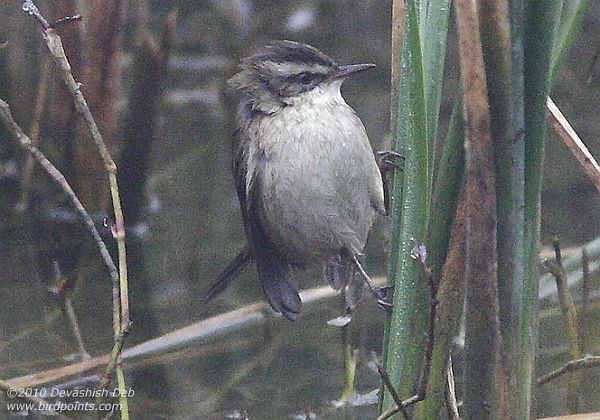|
|
| Moustached Warbler
|
Acrocephalus melanopogon
|
| 21 February 2010 |
|
Possible
regional races (polytypic)
|
|
|
-A. m. albiventris; Kazakov, 1974
|
|
|
-A. m. mimicus; Madarasz, 1903
|
|
|
-A. m. melanopogon; Temminck, 1823
|
|
|
|
|
Notes on Moustached Warbler, Acrocephalus melanopogon
Pls use the mousewheel to zoom in/out (Max 2X)
 Moustached Warbler Acrocephalus melanopogon mimicus, Adult Sultanpur, Haryana, India, 17 January 2010. Foggy conditions allowed me to be very near the bird, but I am really not sure whether it was unaware of my presence. A short 'Chak chak' call helped me find the bird, which for a few tiny morsels was interested in being near the bed of the reedy rush. - DD Key ID features: Bold and white supercilia, a moustachial streak, and other acrocephaline features. Size about 145 mm. No confusion species within NW India. Distribution: Winter visitor, migrating eastwards to Delhi, Etawah upto Kanpur. Reported on passage in may. Found in swamps and reed-beds on the margins of lakes and rivers and have been netted in small Typha beds and seen in the Phragmites reeds. Food: Feeds on tiny morsels picked while probing near the marsh surface. Spiders (Araneida) and beetles (Coleoptera), were identified in diet samples (Schmidt et. al.). Not seen sallying for insects on the wing. Habits Secretive in nature and most of the time prefers staying inside the dense reedy rush but occasionally hops out, covers another 3-4 meters in the open and then abruptly returns to the maze of the upright reed stems. The next exit is from an entirely different portion. It comes out in the open for food or for crossing over to another reedy patch. It invariably cocks its tail while contemplating action. Reference books: Handbook of the Birds of the World (2006), v.11. Old World Flycatchers to Old World Warblers, p.616. Edited by Josep del Hoyo, Andrew Elliott, David A. Christie. Published by Lynx Edicions. Harvey, Bill (2006) (By statement: Bill Harvey, Nikhil Devasar, Bikram Grewal): Atlas of the Birds of Delhi and Haryana, p.247. Published by Rupa & Co. Rasmussen, P.C. & Anderton, J.C. (2005): Birds of South Asia. The Ripley Guide (2 Volumes), v.1, p.302, v.2, p.489. Published by Smithsonian Institution, Washington DC, USA and Lynx Edicions, Barcelona, Spain. Baker, Kevin (1997): Warblers of Europe, Asia and North Africa, p.165. Helm Identification Guide Series. Christopher Helm. Ali, Salim & Ripley S. Dillon (1997): Handbook of the Birds of India and Pakistan, v.8, p.114. Second Edition (Ten Volumes in a box set). Oxford University Press. Ganguli, Usha (1975): A guide to the birds of the Delhi area, p.226. Published by Indian Council of Agricultural Research (New Delhi) Baker, E.C.S. (1924): Fauna of British India: Birds (Second Edition), v.2, p.418. Published under the authority of the Secretary of State for India in Council. Oates, Eugene W. (1889): The Fauna of British India, Including Ceylon and Burma. Birds v.1, p.368. Edited by W.T. Blanford. Published under the authority of the Secretary of State for India in Council. Reference papers: Reed cutting affects arthropod communities, potentially reducing food for passerine birds Martin H. Schmidt1, Gaetan Lefebvre2, Brigitte Poulin2 and Teja Tscharntke1 1 Fachgebiet Agrarokologie, Universitat Gottingen, Waldweg 26, 37073, Gottingen, Germany 2 Station Biologique de la Tour du Valat, Le Sambuc, 13200, Arles, France |
About/Terms
of use etc. in the home page
Copyright ©
2006-2010 birdpoints. All rights reserved.